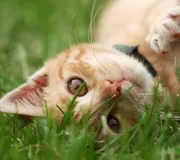Have you recently adopted a longhaired rabbit, such as an Angora? Congratulations! These super fluffy bunnies are almost impossibly cute. However, Floppy won’t be able to keep up with all that fur herself. You’ll need to give her a helping hand with her beauty sessions. A vet offers some advice on this below.
Summer
In summer, you’ll need to be extra careful to keep Floppy dry and clean. Otherwise, she could develop flystrike. Check her skin and coat daily, and make sure her bottom isn’t wet or dirty. Your vet may also recommend a flystrike preventative.
Molting
A few times a year, your rabbit will shed her old coat and grow in a new one. This is called molting, as it’s a bit more intense than regular shedding. Grooming your pet will be especially crucial at these times. If Floppy swallows her fur, she can’t vomit it back up the way a cat would. Therefore, hairballs can cause very dangerous—and even life-threatening—intestinal blockages. Ask your vet for what to look for.
Tools
Be very careful when selecting tools. Whether you choose combs, a slicker brush, a mat rake, or another brush, don’t pull too hard. Bunnies have extremely delicate skin, which rips easily. Generally, you’ll want to start with a wide-toothed comb or a special mat comb. Then, finish up with a tool that has narrower teeth. Ask your vet for more information.
Problem Areas
With longhaired bunnies, their ‘armpits’ and the spots between their legs often get the most mats. Your vet might recommend clipping or even shaving these trouble spots. If you do, be very gentle and use round-edged scissors. Ask for specific advice.
Bathing
You should never bathe a bunny. If Floppy gets something spilled on her fur, you can gently clean off the dirty area. One option is hold your furry pal carefully and, if possible, submerge just the part or her that’s dirty into a tub or sink of lukewarm water. Lightly swish the water around. Never submerge your rabbit’s head or whole body. This is extremely scary for bunnies, and they can actually go into shock from it.
Convincing Floppy
Bunnies are very opinionated, and they can vary greatly in how they react to being groomed. Pick a time when Floppy feels relaxed. As you brush her, talk to her gently, and offer her treats and praise. Don’t try your pet’s patience with long sessions. About 10 or 15 minutes is fine.
Our Advice on Grooming a Longhaired Bunny in 2024
Why do longhaired rabbits need extra grooming attention?
Longhaired rabbits require extra grooming attention due to their dense and abundant fur. This type of coat is prone to matting and tangling, especially in areas like the ‘armpits’ and between the legs. Without regular grooming, mats can cause skin irritation or infections. Moreover, during molting, they can ingest their own fur, leading to dangerous intestinal blockages since rabbits cannot vomit. Regular grooming helps manage these issues, keeping the rabbit’s coat clean and preventing health problems associated with excessive fur ingestion.
Can you bathe your rabbit, or are there alternative cleaning methods?
You should never fully bathe a rabbit, as it can be extremely stressful and may lead to shock. Instead, for cleaning, gently spot-clean dirty areas with a damp cloth or sponge, using lukewarm water. If a specific part of the rabbit is soiled, carefully dip just that portion into lukewarm water and lightly swish around to clean, ensuring you never submerge the rabbit’s head or entire body. Always consult with a veterinarian for safe, rabbit-specific cleaning products and methods to maintain your bunny’s hygiene without causing distress.
How frequently should you be grooming your longhaired rabbit besides during molting?
For longhaired rabbits, regular grooming sessions should occur at least two to three times a week to prevent matting and tangling of their fur. However, during molting periods, which happen a few times a year, you’ll need to increase grooming to daily sessions. This helps manage the excessive shedding and prevents the ingestion of fur, reducing the risk of dangerous intestinal blockages. Always use appropriate tools and gentle techniques to avoid harming their delicate skin. Consult your vet for personalized grooming advice tailored to your rabbit’s specific needs.
Are there foods or supplements that can help reduce shedding or improve your rabbit’s coat health?
A balanced diet rich in essential nutrients can help reduce shedding and improve your rabbit’s coat health. Ensure your rabbit’s diet includes high-quality hay, fresh leafy greens, and a limited amount of pellets. Omega-3 fatty acid supplements, found in flaxseed or certain commercial rabbit foods, can also support skin and coat health. Always provide fresh, clean water to keep their skin hydrated. Before introducing any new foods or supplements, consult with a veterinarian in St. Lucie County, FL, to ensure they’re safe and suitable for your rabbit’s specific health needs.
At what point should you consider taking your rabbit to a professional groomer specializing in rabbits?
Consider taking your rabbit to a professional groomer specializing in rabbits if you encounter grooming challenges such as severe matting or tangling that you cannot safely manage at home. Also, if your rabbit shows extreme stress or behavioral issues during grooming sessions, a professional with experience in handling rabbits might better perform the necessary grooming without causing undue stress. Additionally, suppose your rabbit has specific needs, such as trimming in hard-to-reach areas, or your vet advises you for health reasons. In that case, a professional groomer can provide the appropriate care.
Please contact us, your local animal clinic in St. Lucie County, FL for more information about rabbit care. We’re ‘hoppy’ to help!

